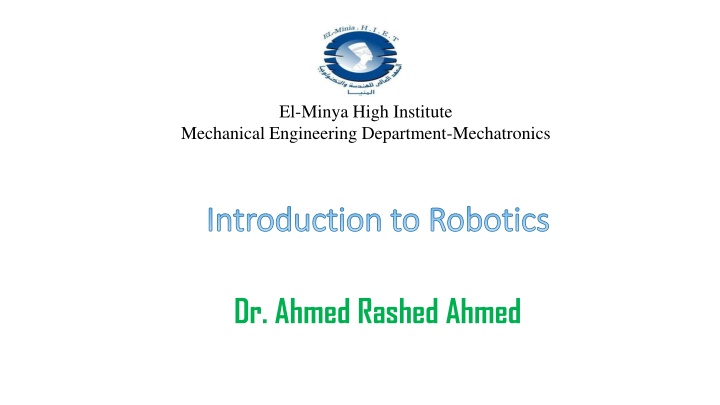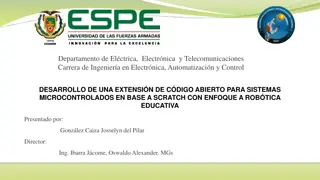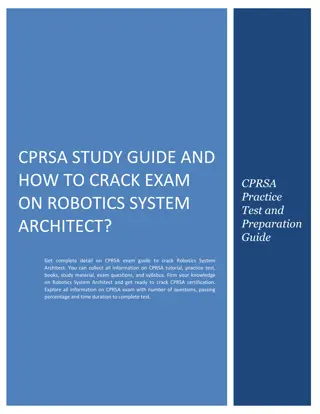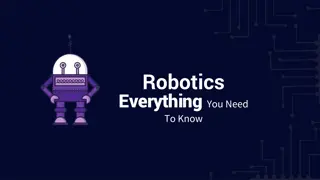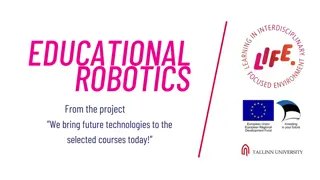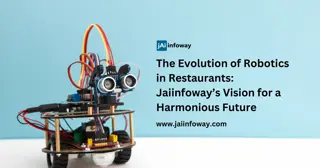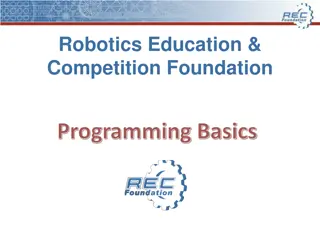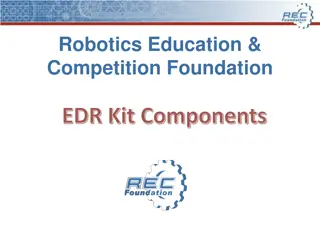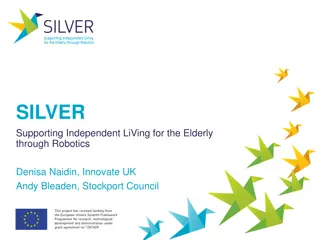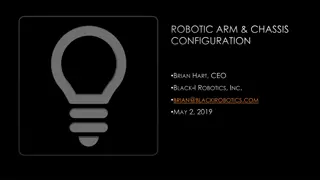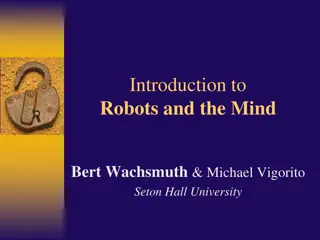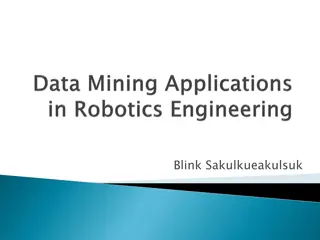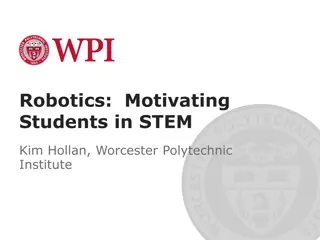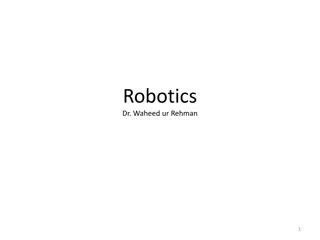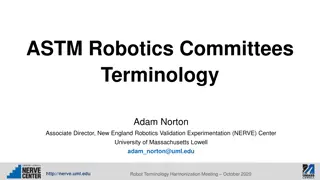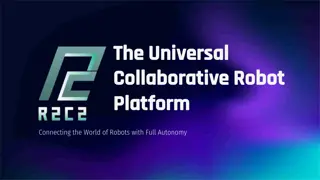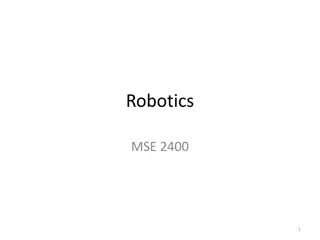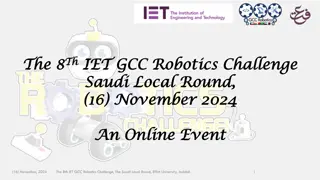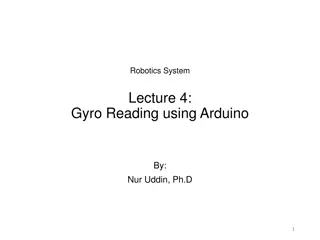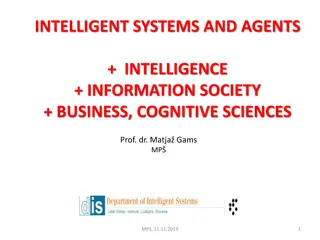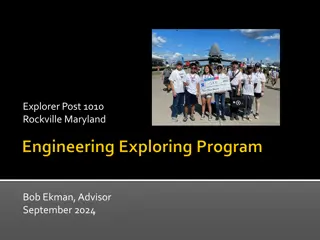Introduction to Robotics
In the world of robotics, a robot is an autonomous machine capable of sensing its environment, making decisions, and taking actions. Learn about the history of robots, their capabilities, and their impact on society through the lens of El-Minya High Institute's Mechanical Engineering Department. Explore the concept of agents, their perception of the environment, and their interaction with it. Delve into the fundamentals of robotics, including kinematics, sensors, actuators, control, and production engineering. Discover the origins of robots in literature, such as Karel apek's play R.U.R. (Rossum's Universal Robots), and how they have evolved into real-world applications.
Download Presentation

Please find below an Image/Link to download the presentation.
The content on the website is provided AS IS for your information and personal use only. It may not be sold, licensed, or shared on other websites without obtaining consent from the author.If you encounter any issues during the download, it is possible that the publisher has removed the file from their server.
You are allowed to download the files provided on this website for personal or commercial use, subject to the condition that they are used lawfully. All files are the property of their respective owners.
The content on the website is provided AS IS for your information and personal use only. It may not be sold, licensed, or shared on other websites without obtaining consent from the author.
E N D
Presentation Transcript
El-Minya High Institute Mechanical Engineering Department-Mechatronics Introduction to Robotics Introduction to Robotics Dr. Ahmed Rashed Ahmed
What is a robot Autonomous agent Scope Kinematic and kinetics Sensors and Actuators Robot vision Path planning Control Production Engineering and Mechanical Design Department Faculty of Engineering - Minia University Dr. Ahmed Rashed Ahmed
The the Czech interwar writer Karel apek in his play R.U.R. (Rossum's Universal Robots), published in 1920. The play begins in a factory that uses a chemical substitute for protoplasm to manufacture living, simplified people called robots. The play does not focus in detail on the technology behind the creation of these living creatures, but in their appearance they prefigure modern ideas of androids, creatures who can be mistaken for humans. These mass-produced workers are depicted as efficient but emotionless, incapable of original thinking and indifferent to self- preservation. word was introduced to the public by robot Production Engineering and Mechanical Design Department Faculty of Engineering - Minia University Dr. Ahmed Rashed Ahmed
A robot is an autonomous machine capable of sensing its environment, carrying out computations to make decisions, and performing actions in the real world. Think of the Roomba robotic vacuum. It uses sensors to autonomously drive around a room, going around furniture and avoiding stairs; it carries out computations to make sure it covers the entire room and when deciding if a spot needs a more thorough cleaning; and it performs an action by sucking dirt, as robotics' Rodney Brooks, one of the Roomba creators, explains. Production Engineering and Mechanical Design Department Faculty of Engineering - Minia University Dr. Ahmed Rashed Ahmed
Production Engineering and Mechanical Design Department Faculty of Engineering - Minia University Dr. Ahmed Rashed Ahmed
An agent is anything can be viewed as perceiving its environment through sensors and acting upon that environment through actuators. Human agent Robot agent Eye ears and other organs Legs hand - mouth Cameras infrared rang motors Production Engineering and Mechanical Design Department Faculty of Engineering - Minia University Dr. Ahmed Rashed Ahmed
The agent program runs on the physical architecture to implement the agent function agent = architecture + program Production Engineering and Mechanical Design Department Faculty of Engineering - Minia University Dr. Ahmed Rashed Ahmed
If the agents actions are based completely on built- in knowledge, we say that the agent lacks autonomy. A system is autonomous to the extent that its behavior is determined its own experience. An autonomous agent is an intelligent agent operating on an owner's behalf but without any interference of that ownership entity. Production Engineering and Mechanical Design Department Faculty of Engineering - Minia University Dr. Ahmed Rashed Ahmed
PEAS: Performance measure, Environment, Actuators, And sensors. To set the PEAS, you must first specify the settings for the smart agent design. Consider, for example, the task of designing an automated taxi driver (SELF DRIVING CAR) and setting the Performance Measurement Environment Actuators Sensors. Production Engineering and Mechanical Design Department Faculty of Engineering - Minia University Dr. Ahmed Rashed Ahmed
You must first specify the settings for the smart agent design: Measure of performance: safe, fast, legal, comfortable travel, maximize profits Environment: Roads, other traffic, pedestrians, customers Actuators: Steering wheel, accelerator, brake, signal, horn Sensors: Cameras, sonar, speedometer, GPS, odometer, motor sensors, keyboard, etc Production Engineering and Mechanical Design Department Faculty of Engineering - Minia University Dr. Ahmed Rashed Ahmed
Features of Environment Features of Environment an environment can have various features from the point of view of an agent: 1. Fully observable vs. Partially Observable 2. Static vs. Dynamic 3. Discrete vs. Continuous 4. Deterministic vs. Stochastic 5. Single-agent vs. Multi-agent 6. Episodic vs. sequential 7. Known vs. Unknown 8. Accessible vs. Inaccessible Production Engineering and Mechanical Design Department Faculty of Engineering - Minia University Dr. Ahmed Rashed Ahmed
1. Fully observable vs. Partially Observable: If an agent sensor can sense or access the complete state of an environment at each point of time then it is a fully observable environment, else it is partially observable. A fully observable environment is easy as there is no need to maintain the internal state to keep track history of the world. An agent with no sensors in all environments then such an environment is called as unobservable. 2. Deterministic vs. Stochastic: If an agent's current state and selected action can completely determine the next state of the environment, then such environment is called a deterministic environment. A stochastic environment is random in nature and cannot be determined completely by an agent. In a deterministic, fully observable environment, agent does not need to worry about uncertainty. Production Engineering and Mechanical Design Department Faculty of Engineering - Minia University Dr. Ahmed Rashed Ahmed
3. Episodic vs. Sequential: In an episodic environment, there is a series of one-shot actions, and only the current percept is required for the action. However, in Sequential environment, an agent requires memory of past actions to determine the next best actions. 4. Single-agent vs. Multi-agent If only one agent is involved in an environment, and operating by itself then such an environment is called single agent environment. However, if multiple agents are operating in an environment, then such an environment is called a multi-agent environment. The agent design problems in the multi-agent environment are different from single agent environment. Production Engineering and Mechanical Design Department Faculty of Engineering - Minia University Dr. Ahmed Rashed Ahmed
5. Static vs. Dynamic: If the environment can change itself while an agent is deliberating then such environment is called a dynamic environment else it is called a static environment. Static environments are easy to deal because an agent does not need to continue looking at the world while deciding for an action. However for dynamic environment, agents need to keep looking at the world at each action. Taxi driving is an example of a dynamic environment whereas Crossword puzzles are an example of a static environment. Production Engineering and Mechanical Design Department Faculty of Engineering - Minia University Dr. Ahmed Rashed Ahmed
6. Discrete vs. Continuous: If in an environment there are a finite number of percepts and actions that can be performed within it, then such an environment is called a discrete environment else it is called continuous environment. A chess game comes under discrete environment as there is a finite number of moves that can be performed. A self-driving car is an example of a continuous environment. 7. Known vs. Unknown Known and unknown are not actually a feature of an environment, but it is an agent's state of knowledge to perform an action. In a known environment, the results for all actions are known to the agent. While in unknown environment, agent needs to learn how it works in order to perform an action. It is quite possible that a known environment to be partially observable and an Unknown environment to be fully observable. Production Engineering and Mechanical Design Department Faculty of Engineering - Minia University Dr. Ahmed Rashed Ahmed
8. Accessible vs. Inaccessible If an agent can obtain complete and accurate information about the state's environment, then such an environment is called an Accessible environment else it is called inaccessible. An empty room whose state can be defined by its temperature is an example of an accessible environment. Information about an event on earth is an example of Inaccessible environment. Production Engineering and Mechanical Design Department Faculty of Engineering - Minia University Dr. Ahmed Rashed Ahmed
Production Engineering and Mechanical Design Department Faculty of Engineering - Minia University Dr. Ahmed Rashed Ahmed
An actuator is a component of a machine that is responsible for moving and controlling a mechanism or system, for example by opening a valve. In simple terms, it is a "mover". An actuator requires a control signal and a source of energy. The control signal is relatively low energy and may be electric voltage or current, pneumatic or hydraulic pressure, or even human power. Its main energy source may be an electric current, or pneumatic pressure. When it receives a control signal, an actuator responds by converting the signal's energy into mechanical motion. An actuator is the mechanism by which a control system acts upon an environment. The control system can be simple (a fixed mechanical or electronic system), software-based (e.g. a printer driver, robot control system), a human, or any other input. hydraulic fluid pressure, Production Engineering and Mechanical Design Department Faculty of Engineering - Minia University Dr. Ahmed Rashed Ahmed
Robotic sensors are used to estimate a robot's condition and environment. These signals are passed to a controller to enable appropriate behavior. Sensors in robots are based on the functions of human sensory organs. Robots require extensive information about their environment in order to function effectively. Sensors provide analogs to human senses and can monitor other phenomena for which humans lack explicit sensors. 1. Simple Touch: Sensing an object's presence or absence. 2. Complex Touch: Sensing an object's size, shape and/or hardness. 3. Simple Force: Measuring force along a single axis. 4. Complex Force: Measuring force along multiple axes. 5. Simple Vision: Detecting edges, holes and corners. 6. Complex Vision: Recognizing objects. 7. Proximity: Non-contact detection of an object. Production Engineering and Mechanical Design Department Faculty of Engineering - Minia University Dr. Ahmed Rashed Ahmed
Sensors can measure physical properties, such as the distance between objects, the presence of light and the frequency of sound. They can measure: 1. Object Proximity: The presence/absence of an object, bearing, color, distance between objects. 2. Physical orientation. The co-ordinates of object in space. 3. Heat: The wavelength of infrared or ultra violet rays, temperature, magnitude, direction. 4. Chemicals: The presence, identity, and concentration of chemicals or reactants. 5. Light: The presence, color, and intensity of light. 6. Sound: The presence, frequency, and intensity of sound. Production Engineering and Mechanical Design Department Faculty of Engineering - Minia University Dr. Ahmed Rashed Ahmed
Production Engineering and Mechanical Design Department Faculty of Engineering - Minia University Dr. Ahmed Rashed Ahmed
A PID controller is an instrument used in industrial control applications to regulate temperature, flow, pressure, speed and other process variables. PID (proportional integral derivative) controllers use a control loop feedback mechanism to control process variables and are the most accurate and stable controller. Production Engineering and Mechanical Design Department Faculty of Engineering - Minia University Dr. Ahmed Rashed Ahmed
